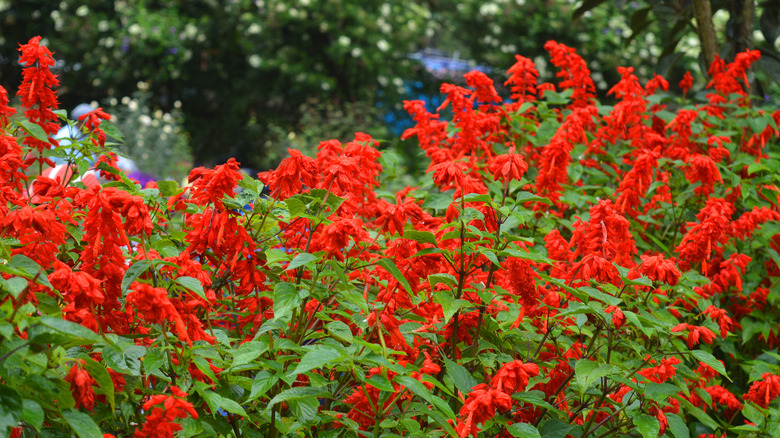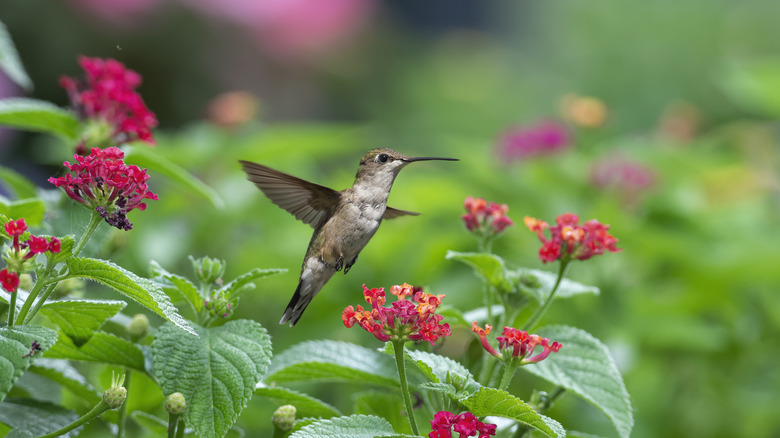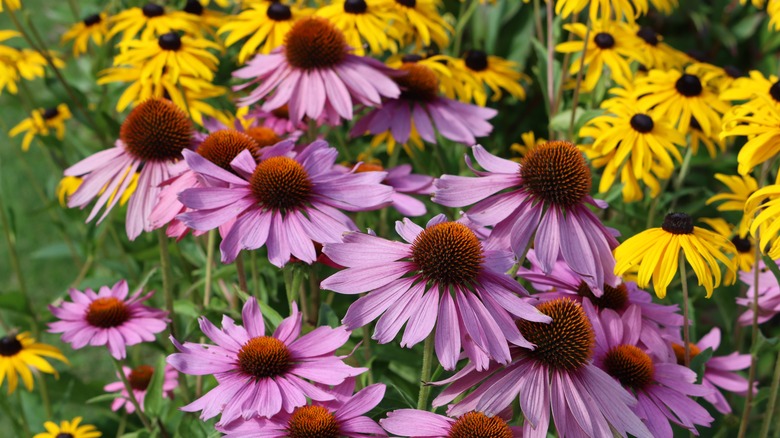Companion Plants To Grow Alongside Scarlet Sage For A Bird-Friendly Garden
Who doesn't love sitting on the porch watching vibrant, beautiful birds flit around the garden? Increasingly, gardeners are embracing bird-friendly beds as a goal, not just a side effect. That's great news because creating gardens that attract and sustain birds and pollinators not only makes for a beautiful garden; it's good for the ecosystem.
Scarlet sage (Salvia coccinea) is a popular plant that attracts birds like cardinals to your garden. Another sought-after garden visitor, the hummingbird, also loves scarlet sage. Still, it can't do all the work. Planting a wide variety of native and wildlife-friendly plants can help attract even more birds to your garden, but, as always, you must choose the right plant for the right spot.
Like most plants, scarlet sage prefers to grow with the plants it shares its native environment with. This is good for busy people and lazy gardeners. Using native plants in your garden makes it lower maintenance and better for local wildlife and the environment to boot. Using low-maintenance companion plants like French marigolds (Tagetes) or black-eyed Susans (Rudbeckia hirta) is a good start, but there are many other options, including coneflowers, butterfly weed, and lavender.
Keep companion planting principles in mind
The principles of companion planting can benefit your garden in many ways. For any garden, selecting compatible plants ensures they remain healthy and provide the right habitat and food sources for a more bird-friendly yard. So, keep the basics of companion planting in mind when you choose the varieties you will use alongside your scarlet sage. Using native plants is the best way to attract your local birds. These species have evolved alongside each other and have a symbiotic relationship.
When selecting species to plant together, you must consider factors such as whether they have similar soil, sun, and water needs. As a native of Mexico and the southeastern United States, scarlet sage loves the sun, requiring six to eight hours of full sun to thrive. When your goal is to also attract birds, you can narrow the companion plants to the ones that encourage winged visitors to stop in your garden. The good news is many beautiful native species fit into this category alongside scarlet sage.
Use these plants alongside scarlet sage to attract more birds
While your garden layout and conditions will dictate which plants you ultimately choose, if you already have scarlet sage growing in your garden, these plants will likely work well and attract the beautiful birds you want to see. Scarlet sage is part of the Salvia family, which houses various flowers in many colors and varieties. Consider planting more than one variety of Salvia in your garden to bring in a wider variety of birds, which may have different preferences.
If you want to shake up the colors and textures in your yard further, the aforementioned French marigolds are not only popular with pollinators, but they have other benefits. The strongly scented plants are known for repelling nematodes as well as other common garden pests. Additionally, coneflowers (Echinacea purpurea) are another North American native species that birds love. Once these sun-loving garden staples go to seed, you will see finches and other birds stopping by for a snack.
Butterfly weed, or Asclepias tuberosa, also loves the same sunny, dry conditions as scarlet sage and has the added benefit of being a medicinal plant. It also gets bonus points for being a favorite of another winged garden visitor, the butterfly. Finally, when you picture lavender fields, you may envision the hot, dry fields of southern France. However, many types of lavender can thrive in the same conditions as scarlet sage. Hummingbirds and other pollinators love the spiky flowers on these fragrant plants. Choose your favorite varieties of these popular flowers for a bright garden that supports the types of birds you want in your yard.


